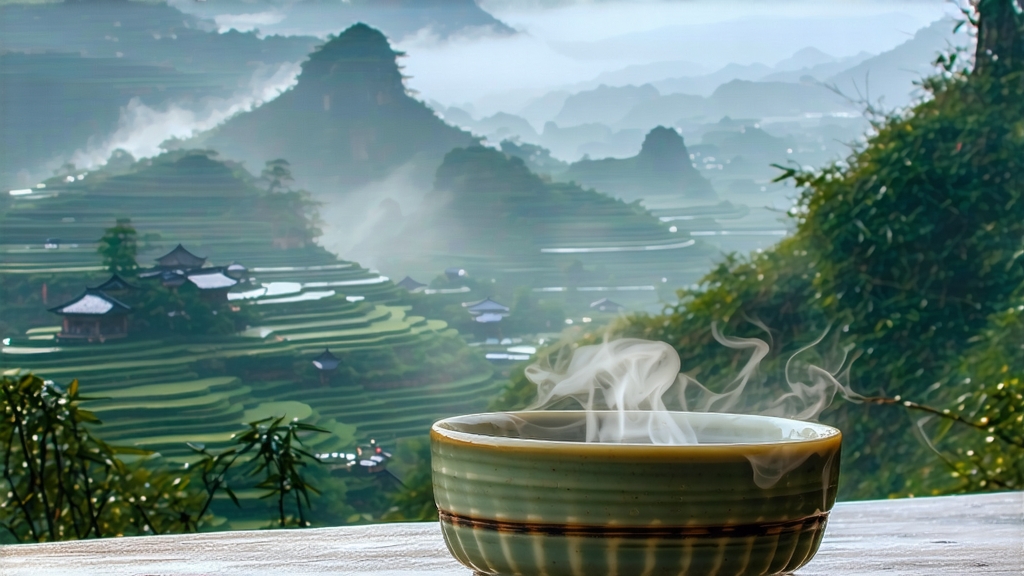
If green tea is the fresh-faced scholar of Chinese teas and pu-erh the bearded sage, then yellow tea is the quiet prince who never boasts of his royal blood. Among the three surviving traditional yellow teas, Meng Ding Huang Ya—literally “Yellow Bud from Meng Summit”—carries the most fragrant whispers of courtly intrigue, Buddhist mountain ritual, and the cool, cloud-wrapped terroir of Sichuan. For most international drinkers it remains a delicious secret, produced in tiny batches for a domestic connoisseur circle that prefers subtlety to spectacle. This essay invites you into that secrecy, tracing the leaf from Tang-dynasty stone inscriptions to your own porcelain gaiwan, and teaching you how to unlock its orchid-sweet, chestnut-cream personality without bruising its fragile dignity.
-
A summit older than tea
Meng Ding Mountain rises just north of Ya’an, where the Sichuan basin collides with the Tibetan plateau. At 1,450 m the air is cool even in July, and mist drifts upward like slow-moving calligraphy. Buddhist monks settled here during the Eastern Han (25-220 CE), and by the Tang (618-907) the court had designated nine peaks “imperial gardens.” A stele dated 816 CE records that monks presented “small-bud yellow cake” to Emperor Xianzong; whether this was fully yellow tea is debated, but the tribute custom was fixed. During the Song (960-1279) the buds were pressed into silver-molded cakes stamped with dragon and phoenix, freighted down the Min River to Kaifeng. After Ming Hongwu’s 1391 edict banning compressed tribute tea, leaf-style Meng Ding Huang Ya emerged, and the Qing court fixed its picking calendar: first rain-free dawn after Qingming, only the single unopened bud, no tools but fingernails to avoid oxidation-triggering bruises. -
Micro-terroir in a sea of clouds
The garden zone sits inside a 30-km cloud belt that blocks 30 % of direct sunlight. Diurnal swing can exceed 12 °C, slowing photosynthesis and stacking amino acids—especially L-theanine—into the tiny buds. Soil is acid yellow loam (pH 4.8-5.2) rich in selenium and zinc, drained by Jurassic sandstone. Cultivar is the local Xiaoye group, a shrub-type Camellia sinensis var. sinensis with 18-22 % soluble sugars and only 4 % catechins, giving natural sweetness without aggressive astringency. Because of altitude, pests are few; no pesticides have been applied in the core zone since 2003, when the area was admitted into the EU-China Geographical Indication agreement. -
The five breaths of yellowing
Meng Ding Huang Ya is often miscatalogued as “light green tea” by exporters who overlook its defining enzymatic yellowing. The craft, transmitted through 12 monk-farmer families, unfolds in five breaths:
First breath: Plucking
Between 5:30 and 7:00 a.m. on the first clear day after Qingming, 18-year-old girls whose body-mass index is below 22 (a rule to ensure steady hands) snap off the dew-weighted bud, never the leaf. Daily quota: 250 g fresh weight per picker.
Second breath: Sha Qing – “killing the green”
Within 90 minutes the buds are wok-fired at 140 °C for 3.5 minutes, enough to denature polyphenol oxidase but preserve 8-10 % moisture. The master listens: when the crackle shifts from popcorn to pine nut, he flicks the buds into bamboo trays.
Third breath: Men Huang – sealed yellowing
The still-warm buds are wrapped in two layers: inner yellow kraft paper, outer wet linen. The parcel is slid into a 28 °C, 75 % RH bamboo chamber and left for 48 hours. During this anaerobic nap, chlorophyll degrades into pheophytin, catechins dimerize into theaflavins, and a hay-like note drifts toward apricot. Every 12 hours the wrapper is opened for a 30-second “breath” to prevent sourness.
Fourth breath: Low-temperature drying
The yellowed buds are baked at 60 °C for 90 minutes on raised bamboo screens, turned every 10 minutes. Moisture drops to